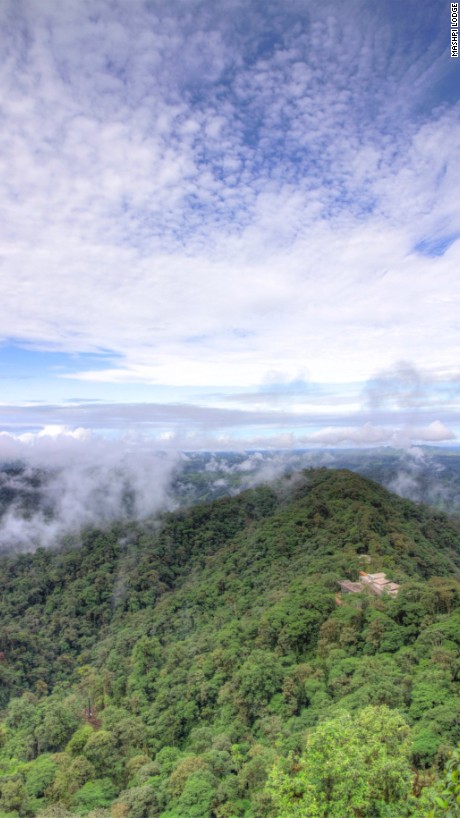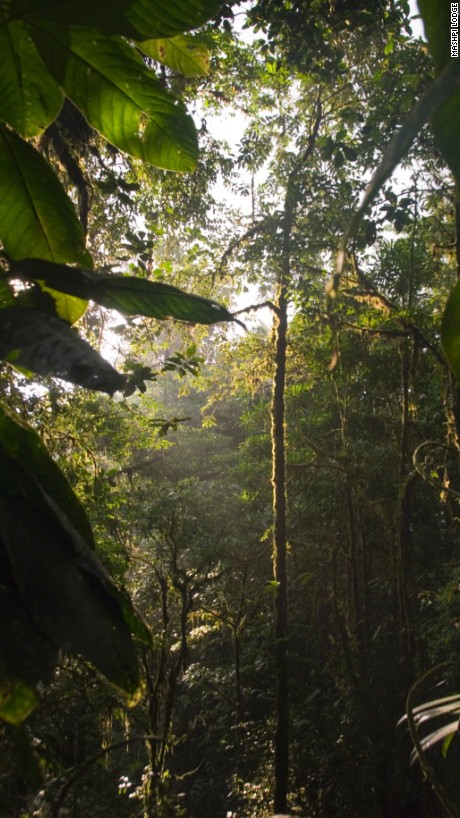Is Ecuador's Mashpi Lodge the most sustainable way to stay in the jungle?
By Andrea Lo, Heidi Pullyard, CNN
Updated 0159 GMT (0959 HKT)
Story highlights
- Ecuadorian eco-resort Mashpi Lodge sits in the middle of the Chocó-Andean forest.
- Constructed using environmentally friendly techniques, the property is designed to be at one with nature.
- It's considered a sustainability success story -- thanks to the architects' painstaking efforts to minimize its impact on the environment.
(CNN)Building a resort in the middle of a forest is nothing new. But few can boast as many credentials in sustainability as this retreat in South America.
Located 950 meters above sea level in the Chocó-Andean forest of Ecuador -- a three-hour drive from the capital of Quito -- Mashpi Lodge is designed to blend seamlessly into one of the most biodiverse spots on the planet.
At the 3,000-acre (1,200-hectare) reserve alone guests can watch the club-winged manakin bird conduct its courtship dance, trek to 190-feet-tall waterfalls, climb an observation canopy into the treetops, or spot the Mashpi torrenteer frog species, discovered by a team of hotel scientists.
"The idea is that you have a symbiosis with all that nature and you become part of the nature," Alfredo Ribadeneira, lead architect behind Mashpi Lodge, tells CNN.

Photos: Ecuador's Mashpi Lodge, a sustainable eco-resort
Show Caption
6 of 9

Photos: Ecuador's Mashpi Lodge, a sustainable eco-resort
Show Caption
7 of 9

Photos: Ecuador's Mashpi Lodge, a sustainable eco-resort
Show Caption
8 of 9

Photos: Ecuador's Mashpi Lodge, a sustainable eco-resort
Show Caption
9 Photos: Ecuador's Mashpi Lodge, a sustainable eco-resort
Show Caption
1 of 9
Photos: Ecuador's Mashpi Lodge, a sustainable eco-resort
Show Caption
2 of 9

Photos: Ecuador's Mashpi Lodge, a sustainable eco-resort
Show Caption
3 of 9

Photos: Ecuador's Mashpi Lodge, a sustainable eco-resort
Show Caption
4 of 9

Photos: Ecuador's Mashpi Lodge, a sustainable eco-resort
Show Caption
5 of 9

Photos: Ecuador's Mashpi Lodge, a sustainable eco-resort
Show Caption
6 of 9

Photos: Ecuador's Mashpi Lodge, a sustainable eco-resort
Show Caption
7 of 9

Photos: Ecuador's Mashpi Lodge, a sustainable eco-resort
Show Caption
8 of 9

Photos: Ecuador's Mashpi Lodge, a sustainable eco-resort
Show Caption
9 of 9

Photos: Ecuador's Mashpi Lodge, a sustainable eco-resort
Show Caption
1 of 9

Photos: Ecuador's Mashpi Lodge, a sustainable eco-resort
Show Caption
2 of 9

Photos: Ecuador's Mashpi Lodge, a sustainable eco-resort
Show Caption
3 of 9

Photos: Ecuador's Mashpi Lodge, a sustainable eco-resort
Show Caption
4 of 9

Photos: Ecuador's Mashpi Lodge, a sustainable eco-resort
Show Caption
5 of 9
At one with nature
The man behind Mashpi Lodge is Ecuadorian entrepreneur, environmentalist, and former mayor of Quito, Roque Sevilla.
A timber company had previously owned the site, which Sevilla purchased 11 years ago, to save the forest and its inhabitants. Two years of building work and $10 million later, the resort opened in 2012.
"I think Mashpi Lodge is a very special case when it comes to the numerous eco-resorts around the world," Sevilla tells CNN.
"(Protection of the area) is an ongoing effort and we're still working on purchasing more land so we can guarantee 100% protection from logging, agriculture and mining."

Mashpi Lodge as seen from an observation tower built for guests.
"The idea was to make a bubble of comfort in the middle of the jungle," explains Ribadeneira. "The real luxury is the possibility of being part of this web of life as a spectator."
On top of the network of logging roads that once covered the site the architects laid a grid of metal mesh tubes "encrusted in the land" to serve as the foundation of the property.
"The time it took to make all the foundations was very long," Ribadeneira says. "In another place, you would just go and dig a hole and put down foundations -- and that's it."
But Ribadeneira and his team took great care to avoid disturbing the forest, where possible.
For example, the timber firm left behind a platform where lumber machinery had been stored. Ribadeneira decided to locate the hotel there: not only did it have expansive views, but it also didn't require trees to be cut down since the site's vegetation had already been removed.
"If you walk around you're not going to see building debris," Marc Berry, the hotel's general manager, tells CNN. "We're very respectful of the forest."
Lost in the jungle
Vertical lines have been used throughout Mashpi Lodge to mirror the forest.
"We tried to make all the vertical elements of the structure very slender and tall, aiming for a similar proportion to the trees nearby," Ribadeneira explains.
Mashpi Lodge's vertical structural elements are designed to evoke a feeling of being "lost" inside the jungle for its guests.
Another way of bringing the forest inside was the extensive use of glass -- there are floor-to-ceiling windows in the guest rooms, for example.
"The glass reflects the jungle; the glass makes you see from the windows. This generates a magnificent relationship with the exterior," Ribadeneira adds.
Furthermore, the hotel was built across three floors to provide a layered view of the forest.
The ground level, where the entrance and communal areas are, offers views of two lateral mountain ranges.
Most of the guest rooms take up the two floors above, looking out into the higher reaches of the forest.
"One moment you ... are at ground level with bases of the trees very close to you -- and the next moment you are practically inside the canopy of the jungle.

Views of the rainforest are visible at every turn from inside Mashpi Lodge.
"The sensation that this generates is very interesting," Ribadeneira says.
In more practical sustainability terms, Mashpi Lodge has been running on hydro-electricity over the past year.
Meanwhile, 75% of the property operates energy efficient LED lights. The lodge sources its water from local rivers and treats it in a natural water plant on site, while used beverage crates are recycled to cover slippery paths.
Local villagers grow organic produce -- fruits and the heart of palm vegetable -- for the hotel's kitchen, reducing the property's carbon footprint.
If you build it, they will come
Ribadeneira admits that the building process was challenging.
"Initially, when the hotel was not yet inhabited, the reflection of the jungle in the windows made the birds crash against the glass," he says.
The team leveled the windows in different angles so the birds wouldn't hit them.

The Cloud Forest surrounding Mashpi Lodge is teeming with wildlife.
Transporting materials to the site and constructing the building was also difficult.
"Normally, you would work with materials that are nearby. In this case, the place is so complex that it's very hard thinking about getting the materials there."
To avoid disturbing the wildlife, the architects used small cars and lots of manpower, rather than trucks. Each sheet of glass was carried in. Parts of the property were built off-site and reassembled once they arrived.
"You have to be very, very silent and you cannot go and have huge trucks and all those things," he explains, or else the wildlife the property wanted to showcase would have fled forever.

Some parts of Mashpi Lodge were pre-assembled in Quito before taking shape on site.
Indeed, an initial downturn in biodiversity proved unavoidable.
"The animals went away -- but after a couple of years they were all back again," says Ribadeneira. "That was a very good thing."
With Mashpi Lodge receiving some 2,200 guests a year, it would seem that their efforts have paid off.
"Ecuador has a lot to offer anyway, but this seems a little bit special in terms of how you can approach the cloud forest and how you can see a little bit more of Ecuador," guest Michael Bloy tells CNN.
"People tend to think of Ecuador as the Galapagos or the rainforest. I think people miss out on here, so this would be a lovely way to come and see it."
- Get link
- X
- Other Apps

Comments
Post a Comment
comments below